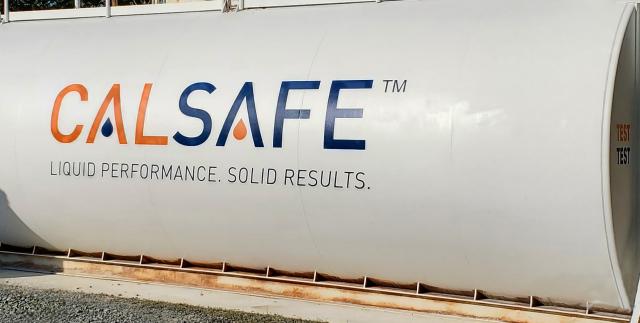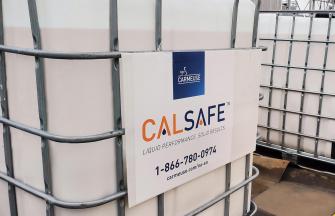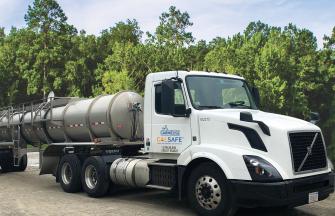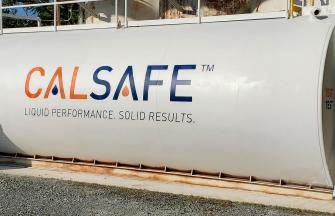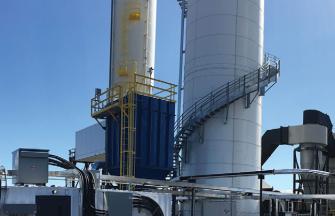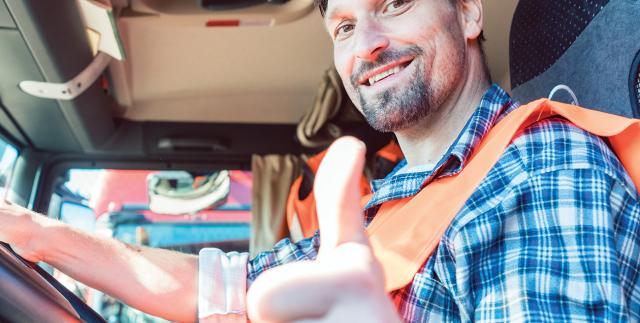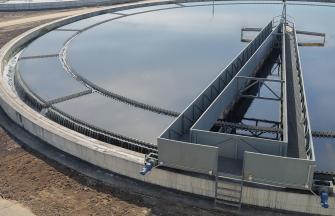
When it comes to safe and efficient delivery, offloading and storage of CALSAFE lime slurry, here is what you need to know.
CALSAFE ready-to-use lime slurry is made by mixing quicklime or hydrated lime with water. It therefore eliminates the challenges posed by handling dry lime products and mixing your own lime slurry at your location.
For more on the differences between CALSAFE lime slurry, quicklime and hydrated lime, see our article: How to Choose the Right Lime Product for your Water/Wastewater Treatment Plant.
But what do you need to know about the safe delivery, handling and storage of CALSAFE lime slurry at your plant? In this article, we answer some of your most-asked questions.
HOW IS CALSAFE LIME SLURRY DELIVERED?
We make CALSAFE lime slurry at four locations: three in the US, in Baltimore, MD, Bellingham, MA, and East Chicago, IL; and one in Canada, at Northern Lime in Blind River, Ontario. From these plants, it is delivered by truck to your location. Each load is delivered by an expert and experienced Carmeuse driver, who is your go-to partner for safe and efficient offloading.
CALSAFE lime slurry is delivered in loads of 4,500-4,600 gallons – the capacity of our tankers. Smaller, partial loads present a safety risk to our drivers and other road users as they may shift during transport, especially when braking, potentially resulting in unwanted and unsafe movement of the truck. Partial loads are therefore generally prohibited, so it is important to make sure you have the space in your storage tank to take the full load before ordering. We recommend storing CALSAFE lime slurry in 7,000-gallon tanks to make sure you have the capacity to add new loads to your existing supply, without first running your tank to empty.
Our representatives communicate closely with you to schedule deliveries to fit your needs and make sure you always have CALSAFE lime slurry available. A well-coordinated delivery timing helps you to optimize storage tank size, keep slurry fresh and suspended, and avoid process interruptions.
WHAT SAFETY MEASURES ARE NEEDED WHEN HANDLING CALSAFE?
Our drivers will always be equipped with the required PPE and trained in the safe offloading of CALSAFE lime slurry.
Contact with lime slurry can cause irritation of the skin and serious eye damage. Safety glasses with eye shields should therefore always be worn. Where there is risk of skin contact, appropriate protective clothing (we recommend long-sleeve shirts) and gloves should also be worn.
If lime slurry does come into contact with the eyes, it is important not to rub but immediately flush with generous amounts of water for at least 15 minutes. The eyelid should be pulled back to ensure that all of the lime particles are washed out. Exposed skin should be washed with large amounts of water.
Medical help should be sought immediately. For complete safety information, see the CALSAFE Safety Data Sheet, available on the Carmeuse website.
WHAT EQUIPMENT DO I NEED?
You will need a pump to hook up to the truck for offloading the CALSAFE lime slurry and a mix tank to keep the lime solids in suspension and avoid solids build-up at the bottom of the tank.
The material handling experts at Carmeuse Systems are available to help with all of your lime slurry handling equipment needs—from system design through installation and commissioning to aftermarket support and maintenance.
HOW DO YOU KEEP THE SLURRY IN SUSPENSION DURING TRANSPORT?
The natural movement of the truck is enough to keep the slurry in suspension during transport. If there are any residual solids left in the truck after offload, these are flushed into your storage tank by our driver as part of the delivery process. This makes sure you receive all of the material you paid for and that build-up of residual solids does not impact following loads. It is all part of our commitment to meet your lime slurry specifications —every time.
WHAT PROBLEMS COULD WE ENCOUNTER WHEN OFFLOADING CALSAFE?
Our expert and experienced drivers are there to make sure delivery of CALSAFE lime slurry to your site is conducted as safely and efficiently as possible. That said, there are a number of things to remember.
When using centrifugal pumps to offload the slurry, you need to prime the pump—either with slurry or an external water source—to remove air pockets before pumping can start. This step is not needed when using a self-priming pump, such as a positive displacement pump.
Our drivers will also make sure the top hatch of the tanker is open before pumping begins. This allows air into the tanker as the slurry is removed. Failure to do this will cause a vacuum to form during offload that can result in a collapse of tanker walls.
IS CALSAFE FLAMMABLE?
CALSAFE lime slurry is not flammable or explosive but does react vigorously with acids, releasing sufficient heat to ignite combustible materials. Therefore, we recommend keeping areas where CALSAFE lime slurry is handled free of flammable materials.
I’m interested in exploring the benefits of CALSAFE lime slurry. How can Carmeuse help?
As a leading expert in lime and its uses, Carmeuse is ideally positioned to advise you on the use of CALSAFE lime slurry in your process. Whether by testing at our state-of-the-art chemical and physical laboratory or through a trial at your site, we are here to support you. Based out of our Innovation Center in Pittsburgh, Pennsylvania, our specialists have over 160 years of combined industry experience and are driven by a desire to help you fully realize the benefits of our products.
For onsite trials of CALSAFE lime slurry, we offer a tote delivery—so you can try before you invest in a full slurry handling and storage system. We can also assist with process analysis and troubleshooting to support the most efficient and cost-effective use of CALSAFE lime slurry in your operation.
For questions about equipment, handling and storage, the experts at Carmeuse Systems, are here to support you in making best choice for your operation. Each of our system designs includes full engineering documentation, secure equipment shipment, start-up support, and commissioning. We also offer aftermarket support and maintenance for both Carmeuse Systems and third-party equipment to keep your process running safely, reliably, and efficiently;
Please click here to download the article.

